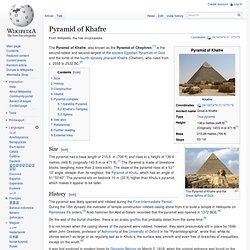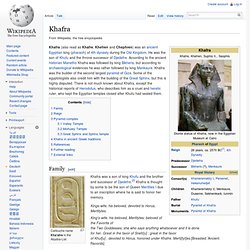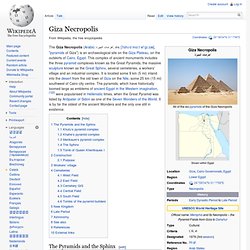

Pyramid of Khafre. The Pyramid of Khafre, also known as the Pyramid of Chephren,[1] is the second-tallest and second-largest of the ancient Egyptian Pyramids of Giza and the tomb of the fourth-dynasty pharaoh Khafre (Chefren), who ruled from c. 2558 to 2532 BC.[2] Size[edit] The pyramid has a base length of 215.5 m (706 ft) and rises to a height of 136.4 metres (448 ft) (originally 143.5 m or 471 ft).[1] The Pyramid is made of limestone blocks (weighing more than 2 tons each).

The slope of the pyramid rises at a 53° 10' angle, steeper than its neighbor, the Pyramid of Khufu, which has an angle of 51°50'40". The pyramid sits on bedrock 10 m (33 ft) higher than Khufu’s pyramid, which makes it appear to be taller. History[edit] The pyramid was likely opened and robbed during the First Intermediate Period. It was first explored in modern times by Giovanni Belzoni on March 2, 1818, when the original entrance was found on the north side of the pyramid and the burial chamber was visited. Construction[edit] Khafra. Khafra (also read as Khafre, Khefren and Chephren) was an ancient Egyptian king (pharaoh) of 4th dynasty during the Old Kingdom.

He was the son of Khufu and the throne successor of Djedefre. According to the ancient historian Manetho Khafra was followed by king Bikheris, but according to archaeological evidences he was rather followed by king Menkaure. Khafra was the builder of the second largest pyramid of Giza. Some of the egyptologists also credit him with the building of the Great Sphinx, but this is highly disputed. There is not much known about Khafra, except the historical reports of Herodotus, who describes him as a cruel and heretic ruler, who kept the Egyptian temples closed after Khufu had sealed them. Family[edit] Cartouche name Kha'afre in the Abydos-List Khafra was a son of king Khufu and the brother and successor of Djedefre.[2] Khafra is thought by some to be the son of Queen Meritites I due to an inscription where he is said to honor her memory. Reign[edit] References[edit] Giza Necropolis.
The Giza Necropolis (Arabic: أهرامات الجيزة, IPA: [ʔɑhɾɑˈmɑːt elˈɡiːzæ], "pyramids of Giza") is an archaeological site on the Giza Plateau, on the outskirts of Cairo, Egypt.

This complex of ancient monuments includes the three pyramid complexes known as the Great Pyramids, the massive sculpture known as the Great Sphinx, several cemeteries, a workers' village and an industrial complex. It is located some 9 km (5 mi) inland into the desert from the old town of Giza on the Nile, some 25 km (15 mi) southwest of Cairo city centre. The pyramids, which have historically loomed large as emblems of ancient Egypt in the Western imagination,[1][2] were popularised in Hellenistic times, when the Great Pyramid was listed by Antipater of Sidon as one of the Seven Wonders of the World. It is by far the oldest of the ancient Wonders and the only one still in existence. The Pyramids. The Pyramids - 3D Virtual Tour The Pyramids virtual tours can be started by clicking the preview window or by downloading the stand-alone versions.

Just drag the mouse to the direction you want to look. Use the scroll wheel to zoom at the details. Press F9 to get a list of the 3D sites you downloaded (residing in the same directory). To install the listed sites as a screensaver press F5. Panorama shootings for The Pyramids were done in the year 2010. History of The Pyramids The Egyptian Pyramids were built as tombs for deceased Pharaohs and their consorts. The best known pyramids are undoubtedly the ones at Giza. The Pyramid of Khafre (143.5 meters high) is believed to be built by Mycerinus, the son of Khafre. The Bent Pyramid in Dahshur is considered the first ‘real’ pyramid. Sun Boat Museum In 1954 a real sized old Egyptian boat was found in a pit near the Great Pyramid. Credits We would like to thank Mr.